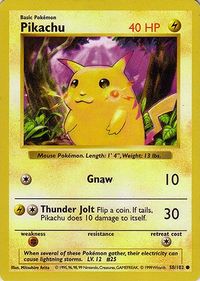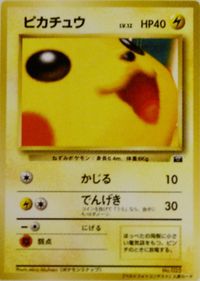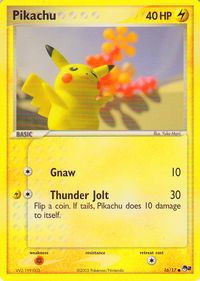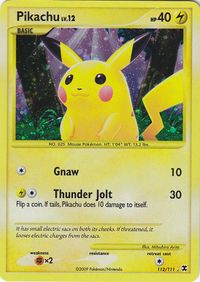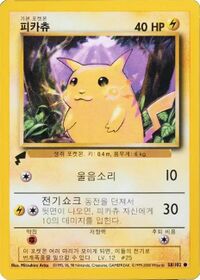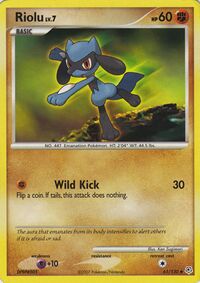Pikachu (Base Set 58): Difference between revisions
Raosunshine (talk | contribs) |
m (Text replacement - "===Origin===↵" to "===Origin=== '''Gnaw''' is an attack that first appeared on {{TCG ID|Base Set|Pikachu|58}} from the {{TCG|Base Set}}. ") Tags: Mobile edit Mobile web edit |
||
| (25 intermediate revisions by 13 users not shown) | |||
| Line 7: | Line 7: | ||
|reprints=4 | |reprints=4 | ||
|reprint1=PikachuSnapBestPhotoContest.jpg | |reprint1=PikachuSnapBestPhotoContest.jpg | ||
|recaption1= | |recaption1={{TCG|Unnumbered Promotional cards|Unnumbered Promotional}} print<br>Photo. [[Mina Akuhara]] | ||
|reprint2=Pikachu16POPSeries2.jpg | |reprint2=Pikachu16POPSeries2.jpg | ||
|recaption2={{TCG|POP Series 2}} print<br>Illus. [[Yuka Morii]] | |recaption2={{TCG|POP Series 2}} print<br>Illus. [[Yuka Morii]] | ||
| Line 20: | Line 20: | ||
|retreatcost=1 | |retreatcost=1 | ||
|retro=yes | |retro=yes | ||
}} | |||
{{PokémoncardInfobox/Expansion|type=Lightning|expansion={{TCG|Base Set}}|rarity={{rar|Common}}|cardno=58/102|jpexpansion={{TCG|Expansion Pack}}|jprarity={{rar|Common}}}} | {{PokémoncardInfobox/Expansion|type=Lightning|expansion={{TCG|Base Set}}|rarity={{rar|Common}}|cardno=58/102|jpexpansion={{TCG|Expansion Pack}}|jprarity={{rar|Common}}}} | ||
{{PokémoncardInfobox/Expansion|type=Lightning|expansion={{TCG|Miscellaneous Promotional cards}}}} | {{PokémoncardInfobox/Expansion|type=Lightning|expansion={{TCG|Miscellaneous Promotional cards}}}} | ||
| Line 29: | Line 29: | ||
{{PokémoncardInfobox/Expansion|type=Lightning|jpdeckkit={{TCG|Intro Pack Neo}}|jphalfdeck=Totodile Half Deck|jpcardno=1}} | {{PokémoncardInfobox/Expansion|type=Lightning|jpdeckkit={{TCG|Intro Pack Neo}}|jphalfdeck=Totodile Half Deck|jpcardno=1}} | ||
{{PokémoncardInfobox/Expansion|type=Lightning|expansion={{TCG|POP Series 2}}|rarity={{rar|Common}}|cardno=16/17|jpexpansion={{TCG|PCG-P Promotional cards}}|jpcardno=068/PCG-P}} | {{PokémoncardInfobox/Expansion|type=Lightning|expansion={{TCG|POP Series 2}}|rarity={{rar|Common}}|cardno=16/17|jpexpansion={{TCG|PCG-P Promotional cards}}|jpcardno=068/PCG-P}} | ||
{{PokémoncardInfobox/Expansion|type=Lightning|expansion={{TCG|Rising Rivals}}|rarity={{rar|Rare | {{PokémoncardInfobox/Expansion|type=Lightning|expansion={{TCG|Rising Rivals}}|rarity={{rar|Rare Secret}}|cardno=112/111|jpexpansion={{TCG|Bonds to the End of Time}}|jprarity={{rar|Ultra-Rare Rare}}|jpcardno=088/090}} | ||
{{PokémoncardInfobox/Expansion|type=Lightning|expansion={{TCG|Pokémon Trading Card Game Classic}}|deck=Charizard & Ho-Oh ex Deck|cardno=008/034|jpexpansion={{TCG|Pokémon Card Game Classic}}|jpdeck=Charizard & Ho-Oh ex Deck|jpcardno=008/032}} | |||
{{PokémoncardInfobox/Footer|type=Lightning|species=Pikachu}} | {{PokémoncardInfobox/Footer|type=Lightning|species=Pikachu}} | ||
| Line 35: | Line 36: | ||
==Card text== | ==Card text== | ||
===Initial prints=== | |||
{{Cardtext/Header|type=Lightning}} | {{Cardtext/Header|type=Lightning}} | ||
{{Cardtext/Attack | {{Cardtext/Attack | ||
| Line 44: | Line 46: | ||
|damage=10 | |damage=10 | ||
|effect= | |effect= | ||
}} | |||
{{Cardtext/Attack | {{Cardtext/Attack | ||
|type=Lightning | |type=Lightning | ||
| Line 51: | Line 53: | ||
|jname=でんげき | |jname=でんげき | ||
|jtrans=Electric Attack | |jtrans=Electric Attack | ||
|jgroup=Electric Shock or Thunder Jolt | |||
|damage=30 | |damage=30 | ||
|effect=Flip a | |effect=Flip a coin. If tails, {{tt|Pikachu|this Pokémon}} does 10 damage to itself. | ||
}} | |||
{{Cardtext/Footer}} | {{Cardtext/Footer}} | ||
| Line 69: | Line 72: | ||
|jdex=ほっぺたの両側に小さい電気袋をもつ。ピンチのときに放電する。 | |jdex=ほっぺたの両側に小さい電気袋をもつ。ピンチのときに放電する。 | ||
|transdex=It has small electric sacs on both cheeks. If threatened, it looses electric charges from the sacs. | |transdex=It has small electric sacs on both cheeks. If threatened, it looses electric charges from the sacs. | ||
}} | |||
===Pokédex data (Rising Rivals print)=== | ===Pokédex data (Rising Rivals print)=== | ||
| Line 81: | Line 84: | ||
|weight=13.2 | |weight=13.2 | ||
|jweight=6 | |jweight=6 | ||
|dex=It has small electric sacs on both cheeks. If threatened, it looses electric charges from the sacs. | |dex=It has small electric sacs on both its cheeks. If threatened, it looses electric charges from the sacs. | ||
|jdex=ほっぺたの りょうがわに ちいさい でんきぶくろを もつ。 ピンチのときに ほうでんする。 | |jdex=ほっぺたの りょうがわに ちいさい でんきぶくろを もつ。 ピンチのときに ほうでんする。 | ||
|}} | }} | ||
===Pokémon Trading Card Game Classic print=== | |||
{{Cardtext/Header|type=Lightning}} | |||
{{Cardtext/Attack | |||
|type=Lightning | |||
|cost={{e|Colorless}} | |||
|name=Gnaw | |||
|jname=かじる | |||
|jtrans=Gnaw | |||
|damage=10 | |||
|effect= | |||
}} | |||
{{Cardtext/Attack | |||
|type=Lightning | |||
|cost={{e|Lightning}}{{e|Colorless}} | |||
|name=Thunder Jolt | |||
|jname=でんげき | |||
|jtrans=Electric Attack | |||
|jgroup=Electric Shock or Thunder Jolt | |||
|damage=30 | |||
|effect=Flip a coin. If tails, this Pokémon also does 10 damage to itself. | |||
}} | |||
{{Cardtext/Footer}} | |||
===Pokédex data (Pokémon Trading Card Game Classic print)=== | |||
{{Carddex | |||
|type=Lightning | |||
|name=Pikachu | |||
|species=Mouse | |||
|ndex=25 | |||
|height=1'4" | |||
|jheight=0.4 | |||
|weight=13.2 | |||
|jweight=6 | |||
|dex=When several of these Pokémon gather, their electricity can cause lightning storms. | |||
|jdex=ほっぺたの両側に小さい電気袋をもつ。ピンチのときに放電する。 | |||
|transdex=It has small electric sacs on both cheeks. If threatened, it looses electric charges from the sacs. | |||
}} | |||
==Release information== | ==Release information== | ||
This card was | This card was included in the {{TCG|Base Set}} with artwork by [[Mitsuhiro Arita]], first released in the Japanese {{TCG|Expansion Pack}}. It has two versions: a red-cheeked variant and the true yellow-cheeked version. The split between red cheeks and yellow cheeks is estimated to be 50% in {{TCG|1st Edition}} and {{TCG|Shadowless}} print runs; however, the {{TCG|Unlimited}} print run only features the yellow cheeks version making the red cheeks version more sought after. Both versions also have promotional variants with a gold foil "E<sup>3</sup>" stamp where the expansion symbol would be present in subsequent sets. The yellow-cheeked version was available as an insert in the September 1999 issue of ''Nintendo Power'', while the red-cheeked variant was distributed to those who visited the Nintendo booth at the {{wp|Electronic Entertainment Expo}} (E3) between May 13 and 15, 1999. Similarly to the non-promotional versions, the red-cheeked variant is considerably more valuable. | ||
The card was later reprinted in the | The yellow-cheeked version of the Base Set print also has another promotional variant with a gold foil "PokéTour 1999" stamp in the top right corner of the illustration. This card was included in 'Tour packs' distributed at locations visited by the PokéTour in Australia in 1999, which were advertised to be limited to 3,000 at each venue. The PokéTour consisted of two separate tours: Red, which ran on weekends from September 18 to October 9, 1999; and Blue, which ran on weekends from September 18 to October 7, 1999. A {{TCG|Jumbo card|Jumbo}} version of the yellow-cheeked Base Set print was included with the February 2000 issue of ''Top Deck Magazine''. This print has "Not for Play Use" in red on the reverse of the card. A Korean version of yellow-cheeked Base Set print was also included in the {{TCG|Pikachu World Collection 2000|Pikachu World Collection}}, available to purchase exclusively at Pokémon Park 2000 held at Sydney University, Sydney, Australia from September 12 to October 4, 2000. This print features a gold foil Pikachu tail stamp on the left edge under the illustration window. | ||
In Japan, it was reprinted as an {{TCG|Unnumbered Promotional cards|Unnumbered Promotional card}} with artwork by [[Mina Akuhara]], one of five winning entries of the ''CoroCoro'' [[Pokémon Snap]] {{DL|Illustration contests|CoroCoro Best Photo Contest|Best Photo Contest}}, which was held between May 15 and June 14, 1999. This print has a camera graphic in place of an expansion symbol and text on the bottom of the card border that reads: "''"Best Photo Contest" winning card''". According to the article in the August 1999 issue ''CoroCoro Comic'' that announced the winning entries, each entrant was to receive twenty copies of a card featuring their photograph. | |||
An English version of the yellow-cheeked Base Set print on Japanese card stock was included in the ''[[Pokémon Song Best Collection]]'' CD, released on January 1, 1999. The yellow-cheeked version of the Base Set print was reprinted in the Bulbasaur Deck of the Japanese {{TCG|Intro Pack}}, in the {{TCG|Base Set 2}} expansion, and in the Totodile Half Deck of the Japanese {{TCG|Intro Pack Neo}}. | |||
This card was later reprinted in the {{TCG|POP Series 2}} with new artwork by [[Yuka Morii]], first released as one of the Japanese {{TCG|PCG-P Promotional cards}}. In Japan, it was available as part of a Meiji Chocolate campaign in June 2005. A {{TCG|retro card|special reprint}} was included in the {{TCG|Rising Rivals}} expansion with redrawn art by Mitsuhiro Arita, first released in the Japanese {{TCG|Bonds to the End of Time}} expansion. | |||
Another Jumbo version of the yellow-cheeked Base Set print was included in copies of the {{TCGMerch|Sword & Shield|Series|First Partner Collector's Binder}}, released on February 26, 2021 in celebration of the [[Pokémon 25th Anniversary|25th Anniversary]] of the Pokémon franchise. This print lacks the [[Wizards of the Coast]] copyright and features a foil Pokémon 25th Anniversary logo in the bottom right corner of the illustration window. | |||
In the Scarlet & Violet Series, this card was reprinted in Holofoil with its original {{TCG|Base Set}} artwork for the Charizard & Ho-Oh ex deck of the {{TCG|Pokémon Card Game Classic}}. This reprint lacks a regulation mark and is thus not legal for tournament play. | |||
===Gallery=== | ===Gallery=== | ||
| Line 97: | Line 148: | ||
|illus1=Mitsuhiro Arita | |illus1=Mitsuhiro Arita | ||
|image2=Pikachu Red Cheek Variant.jpg | |image2=Pikachu Red Cheek Variant.jpg | ||
|caption2=Altered Base Set print | |caption2=Altered {{TCG|Base Set}} print<br>Illus. [[Mitsuhiro Arita]] | ||
|image3=PikachuSnapBestPhotoContest.jpg | |image3=PikachuSnapBestPhotoContest.jpg | ||
|caption3= | |caption3={{TCG|Unnumbered Promotional cards|Unnumbered Promotional}} print<br>Photo. [[Mina Akuhara]] | ||
|image4=Pikachu16POPSeries2.jpg | |image4=Pikachu16POPSeries2.jpg | ||
|set4=POP Series 2 | |set4=POP Series 2 | ||
| Line 106: | Line 157: | ||
|set5=Rising Rivals | |set5=Rising Rivals | ||
|illus5=Mitsuhiro Arita | |illus5=Mitsuhiro Arita | ||
|}} | |image6=Pikachu-World-Collection-2000-Korean.jpg | ||
|set6=Pikachu World Collection 2000 | |||
|illus6=Mitsuhiro Arita | |||
}} | |||
{{TCGGallery | |||
|type=Lightning | |||
|image1=TCG1 A19 Pikachu.png | |||
|size1=64px | |||
|caption1={{TCG GB1}} {{GB|1|Colosseum}} sprite | |||
|image2=TCG2 A28 Pikachu.png | |||
|size2=64px | |||
|caption2={{TCG GB2}} {{GB|2|Beginning Pokémon}} sprite | |||
}} | |||
==Trivia== | ==Trivia== | ||
*This card is popularly known as ''Yellow Cheeks Pikachu'' as a reference to the card's artwork and to differ it from {{OBP|Pikachu|Jungle 60}} card from the {{TCG|Jungle}} expansion. This name also appeared in some instruction manuals produced by [[Wizards of the Coast]]. | *This card is popularly known as ''Yellow Cheeks Pikachu'' as a reference to the card's artwork and to differ it from {{OBP|Pikachu|Jungle 60}} card from the {{TCG|Jungle}} expansion. This name also appeared in some instruction manuals produced by [[Wizards of the Coast]]. | ||
*The original Japanese version depicts Pikachu with yellow cheeks. However, Wizards of the Coast, when releasing this card for the first time in English, deliberately recolored Pikachu's cheeks red in an effort to make it more recognizable. Wizards would however later reverse this decision in subsequent reprints of the card and return Pikachu's cheeks to their original yellow color; because of this reversal the original red cheeks is commonly mistaken to be an error | *The original Japanese version depicts Pikachu with yellow cheeks. However, Wizards of the Coast, when releasing this card for the first time in English, deliberately recolored Pikachu's cheeks red in an effort to make it more recognizable. Wizards would however later reverse this decision in subsequent reprints of the card and return Pikachu's cheeks to their original yellow color; because of this reversal the original red cheeks is commonly mistaken to be an error. | ||
*Although not part of a numbered promotional set, the Pikachu distributed at E3 in 1999 | *Although not part of a numbered promotional set, the Pikachu distributed at E3 in 1999 was the first English promotional card. | ||
===Origin=== | ===Origin=== | ||
Thunder Jolt is a [[move]] in the [[Super Smash Bros.]] series that {{p|Pikachu}} can use. This card's English [[Pokédex]] entry comes from {{game|Red and Blue|s}}, though it is slightly reworded. The Japanese entry comes from {{game|Red and Green|s}}. The Rising Rivals Pokédex entry comes from {{game|FireRed}} | '''Gnaw''' is an attack that first appeared on {{TCG ID|Base Set|Pikachu|58}} from the {{TCG|Base Set}}. Thunder Jolt is a [[move]] in the [[Super Smash Bros.]] series that {{p|Pikachu}} can use. This card's English [[Pokédex]] entry comes from {{game|Red and Blue|s}}, though it is slightly reworded. The Japanese entry comes from {{game|Red and Green|s}}. The Rising Rivals Pokédex entry comes from {{game|FireRed}}. | ||
{{Project TCG notice}} | {{Project TCG notice}} | ||
| Line 127: | Line 190: | ||
[[Category:Rising Rivals cards]] | [[Category:Rising Rivals cards]] | ||
[[Category:Bonds to the End of Time cards]] | [[Category:Bonds to the End of Time cards]] | ||
[[Category:Pokémon Trading Card Game Classic cards]] | |||
[[Category:Pokémon Card Game Classic cards]] | |||
[[Category:Illus. by Mitsuhiro Arita]] | [[Category:Illus. by Mitsuhiro Arita]] | ||
[[Category:Photo. by Mina Akuhara]] | [[Category:Photo. by Mina Akuhara]] | ||
| Line 134: | Line 199: | ||
[[Category:Secret cards]] | [[Category:Secret cards]] | ||
[[de:Pikachu ( | [[de:Pikachu (Grundset 58)]] | ||
[[es:Pikachu (Base Set TCG)]] | |||
[[fr:Pikachu (Set de Base 58)]] | [[fr:Pikachu (Set de Base 58)]] | ||
[[it:Pikachu (Set Base 58)]] | |||
[[ja:ピカチュウ (第1弾)]] | [[ja:ピカチュウ (第1弾)]] | ||
[[ | [[zh:皮卡丘(基本系列)]] | ||
Latest revision as of 19:09, 24 October 2024
| ||||||||||||||||||||||||||||||||||||||||||||||||||||||||||||||||||||||||||||||||||||||||||||||||||||||||||||
| ||||||||||||||||||||||||||||||||||||||||||||||||||||||||||||||||||||||||||||||||||||||||||||||||||||||||||||
| ||||||||||||||||||||||||||||||||||||||||||||||||||||||||||||||||||||||||||||||||||||||||||||||||||||||||||||
Pikachu (Japanese: ピカチュウ Pikachu) is a Lightning-type Basic Pokémon card. It was first released as part of the Base Set.
Card text
Initial prints
Pokédex data (Base Set and Base Set 2 prints)
Pokédex data (Rising Rivals print)
Pokémon Trading Card Game Classic print
Pokédex data (Pokémon Trading Card Game Classic print)
Release information
This card was included in the Base Set with artwork by Mitsuhiro Arita, first released in the Japanese Expansion Pack. It has two versions: a red-cheeked variant and the true yellow-cheeked version. The split between red cheeks and yellow cheeks is estimated to be 50% in 1st Edition and Shadowless print runs; however, the Unlimited print run only features the yellow cheeks version making the red cheeks version more sought after. Both versions also have promotional variants with a gold foil "E3" stamp where the expansion symbol would be present in subsequent sets. The yellow-cheeked version was available as an insert in the September 1999 issue of Nintendo Power, while the red-cheeked variant was distributed to those who visited the Nintendo booth at the Electronic Entertainment Expo (E3) between May 13 and 15, 1999. Similarly to the non-promotional versions, the red-cheeked variant is considerably more valuable.
The yellow-cheeked version of the Base Set print also has another promotional variant with a gold foil "PokéTour 1999" stamp in the top right corner of the illustration. This card was included in 'Tour packs' distributed at locations visited by the PokéTour in Australia in 1999, which were advertised to be limited to 3,000 at each venue. The PokéTour consisted of two separate tours: Red, which ran on weekends from September 18 to October 9, 1999; and Blue, which ran on weekends from September 18 to October 7, 1999. A Jumbo version of the yellow-cheeked Base Set print was included with the February 2000 issue of Top Deck Magazine. This print has "Not for Play Use" in red on the reverse of the card. A Korean version of yellow-cheeked Base Set print was also included in the Pikachu World Collection, available to purchase exclusively at Pokémon Park 2000 held at Sydney University, Sydney, Australia from September 12 to October 4, 2000. This print features a gold foil Pikachu tail stamp on the left edge under the illustration window.
In Japan, it was reprinted as an Unnumbered Promotional card with artwork by Mina Akuhara, one of five winning entries of the CoroCoro Pokémon Snap Best Photo Contest, which was held between May 15 and June 14, 1999. This print has a camera graphic in place of an expansion symbol and text on the bottom of the card border that reads: ""Best Photo Contest" winning card". According to the article in the August 1999 issue CoroCoro Comic that announced the winning entries, each entrant was to receive twenty copies of a card featuring their photograph.
An English version of the yellow-cheeked Base Set print on Japanese card stock was included in the Pokémon Song Best Collection CD, released on January 1, 1999. The yellow-cheeked version of the Base Set print was reprinted in the Bulbasaur Deck of the Japanese Intro Pack, in the Base Set 2 expansion, and in the Totodile Half Deck of the Japanese Intro Pack Neo.
This card was later reprinted in the POP Series 2 with new artwork by Yuka Morii, first released as one of the Japanese PCG-P Promotional cards. In Japan, it was available as part of a Meiji Chocolate campaign in June 2005. A special reprint was included in the Rising Rivals expansion with redrawn art by Mitsuhiro Arita, first released in the Japanese Bonds to the End of Time expansion.
Another Jumbo version of the yellow-cheeked Base Set print was included in copies of the First Partner Collector's Binder, released on February 26, 2021 in celebration of the 25th Anniversary of the Pokémon franchise. This print lacks the Wizards of the Coast copyright and features a foil Pokémon 25th Anniversary logo in the bottom right corner of the illustration window.
In the Scarlet & Violet Series, this card was reprinted in Holofoil with its original Base Set artwork for the Charizard & Ho-Oh ex deck of the Pokémon Card Game Classic. This reprint lacks a regulation mark and is thus not legal for tournament play.
Gallery
|
|
| ||||||
|
|
|
|
|
Trivia
- This card is popularly known as Yellow Cheeks Pikachu as a reference to the card's artwork and to differ it from Pikachu card from the Jungle expansion. This name also appeared in some instruction manuals produced by Wizards of the Coast.
- The original Japanese version depicts Pikachu with yellow cheeks. However, Wizards of the Coast, when releasing this card for the first time in English, deliberately recolored Pikachu's cheeks red in an effort to make it more recognizable. Wizards would however later reverse this decision in subsequent reprints of the card and return Pikachu's cheeks to their original yellow color; because of this reversal the original red cheeks is commonly mistaken to be an error.
- Although not part of a numbered promotional set, the Pikachu distributed at E3 in 1999 was the first English promotional card.
Origin
Gnaw is an attack that first appeared on Pikachu from the Base Set. Thunder Jolt is a move in the Super Smash Bros. series that Pikachu can use. This card's English Pokédex entry comes from Pokémon Red and Blue, though it is slightly reworded. The Japanese entry comes from Pokémon Red and Green. The Rising Rivals Pokédex entry comes from Pokémon FireRed.

|
This article is part of Project TCG, a Bulbapedia project that aims to report on every aspect of the Pokémon Trading Card Game. |
- Cards
- Pokémon cards
- Pikachu (TCG)
- Pokémon cards with 40 HP
- Pokémon cards with a Retreat Cost of 1
- Basic Pokémon cards
- Lightning-type Pokémon cards
- Cards with Gnaw
- Pokémon cards with attack damage 10
- Cards with Thunder Jolt
- Cards with Electric Shock or Thunder Jolt (でんげき)
- Pokémon cards with attack damage 30
- Base Set cards
- Expansion Pack cards
- Promotional cards
- Intro Pack cards
- Base Set 2 cards
- Intro Pack Neo cards
- POP Series 2 cards
- PCG-P Promotional cards
- Rising Rivals cards
- Bonds to the End of Time cards
- Pokémon Trading Card Game Classic cards
- Pokémon Card Game Classic cards
- Illus. by Mitsuhiro Arita
- Photo. by Mina Akuhara
- Illus. by Yuka Morii
- Holographic cards
- Jumbo cards
- Secret cards


